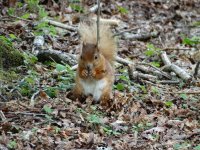London WWT, 25th May
This was the only nice day of a fairly miserable bank holiday weekend around here so I decided to make the most of it with a trip out to London WWT at Barnes. It's an site I really enjoy going to although it tends to make for a fairly long and tiring day out - usually worth it though and this occasion was no exception. There were lots of young about and that's to be expected given the time of year but it's always quite pleasing to see various chicks, especially when some of them are 'chick ticks' i.e. the first time I have seen the young of a particular species even though I am familiar with the adults. Chick ticks from this visit included Lapwing and Long-Tailed Tit, plus some great views of juvenile Starlings from Peacock Tower.
A reasonable number of waders about too, which is pleasing given the time of year. Last time I was here there were two Bar-Tailed Godwits - a male and a female - but this time only the female was around but she was in almost exactly the same spot as last time. Must be good eating round there if you're a Barwit. There were also Ringed Plovers and Little Ringed Plovers on the scrape, plus a Common Sandpiper. Other than that there were the usual mix of gulls, ducks and so on.
The only other thing of any real note was a Reed Warbler offering decent views, in exactly the same place as last time (outside the Wetlands Living hut). I like it when birds are dependable and can be relied on to be in the same place each time one visits. That seems to be the case for both this Reed Warbler and the femal Barwit.
London WWT list:
Bar-Tailed Godwit, Blackbird, Blackcap, Black-headed Gull, Blue Tit, Canada Goose & young, Carrion Crow, Cetti's Warbler, Chaffinch, Chiffchaff, Common Sandpiper, Common Tern, Coot & young, Dunnock, Egyptian Goose, Gadwall, Great Black Backed Gull, Great Crested Grebe, Great Spotted Woodpecker, Great Tit, Green Woodpecker, Greenfinch, Grey Heron, Greylag Goose, Herring Gull, House Sparrow, Jackdaw, Jay, Lapwing & chicks, Lesser Black Backed Gull, Little Grebe, Little Ringed Plover, Long-tailed Tits & young, Magpie, Mallard, Moorhen, Mute Swan & cygnets, Parakeet, Pied Wagtail, Pochard, Redshank, Reed Bunting, Reed Warbler, Ringed Plover, Robin, Sand Martin, Shoveler, Starling & young, Swift, Tufted Duck, Woodpigeon, Wren
The only mammal of any note was the ubiquitous Grey Squirrel.
Still many more updates to this thread to come, I'll try and rattle some more out this afternoon/evening...
This was the only nice day of a fairly miserable bank holiday weekend around here so I decided to make the most of it with a trip out to London WWT at Barnes. It's an site I really enjoy going to although it tends to make for a fairly long and tiring day out - usually worth it though and this occasion was no exception. There were lots of young about and that's to be expected given the time of year but it's always quite pleasing to see various chicks, especially when some of them are 'chick ticks' i.e. the first time I have seen the young of a particular species even though I am familiar with the adults. Chick ticks from this visit included Lapwing and Long-Tailed Tit, plus some great views of juvenile Starlings from Peacock Tower.
A reasonable number of waders about too, which is pleasing given the time of year. Last time I was here there were two Bar-Tailed Godwits - a male and a female - but this time only the female was around but she was in almost exactly the same spot as last time. Must be good eating round there if you're a Barwit. There were also Ringed Plovers and Little Ringed Plovers on the scrape, plus a Common Sandpiper. Other than that there were the usual mix of gulls, ducks and so on.
The only other thing of any real note was a Reed Warbler offering decent views, in exactly the same place as last time (outside the Wetlands Living hut). I like it when birds are dependable and can be relied on to be in the same place each time one visits. That seems to be the case for both this Reed Warbler and the femal Barwit.
London WWT list:
Bar-Tailed Godwit, Blackbird, Blackcap, Black-headed Gull, Blue Tit, Canada Goose & young, Carrion Crow, Cetti's Warbler, Chaffinch, Chiffchaff, Common Sandpiper, Common Tern, Coot & young, Dunnock, Egyptian Goose, Gadwall, Great Black Backed Gull, Great Crested Grebe, Great Spotted Woodpecker, Great Tit, Green Woodpecker, Greenfinch, Grey Heron, Greylag Goose, Herring Gull, House Sparrow, Jackdaw, Jay, Lapwing & chicks, Lesser Black Backed Gull, Little Grebe, Little Ringed Plover, Long-tailed Tits & young, Magpie, Mallard, Moorhen, Mute Swan & cygnets, Parakeet, Pied Wagtail, Pochard, Redshank, Reed Bunting, Reed Warbler, Ringed Plover, Robin, Sand Martin, Shoveler, Starling & young, Swift, Tufted Duck, Woodpigeon, Wren
The only mammal of any note was the ubiquitous Grey Squirrel.
Still many more updates to this thread to come, I'll try and rattle some more out this afternoon/evening...




